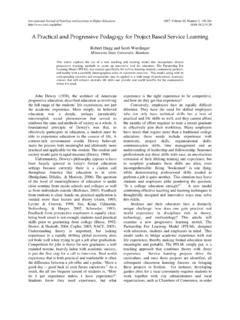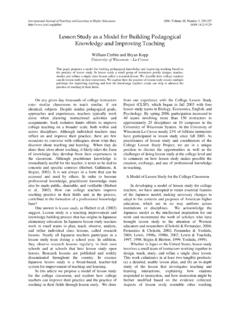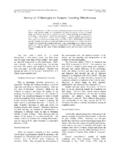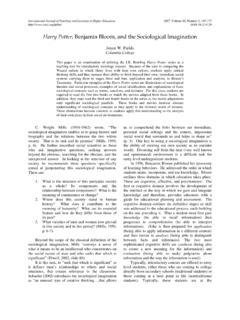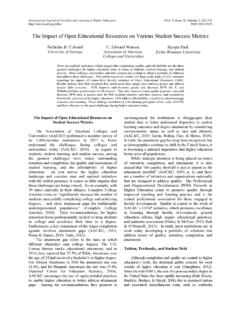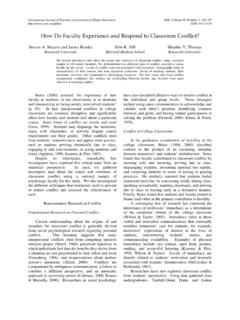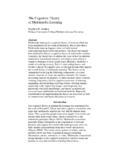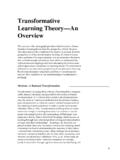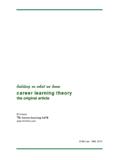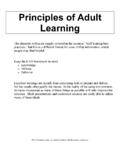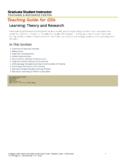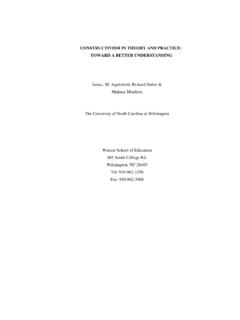Transcription of Enhancing Learning by Integrating Theory and …
1 International Journal of Teaching and Learning in Higher Education 2009, Volume 21, Number 2, 258-265 ISSN 1812-9129 Enhancing Learning by Integrating Theory and Practice Jan Wrenn and Bruce Wrenn Andrews University Educators in professional degree programs are charged with multiple responsibilities in the classroom and in practice settings. We apply our professional knowledge in a variety of settings to serve our communities; we reflect on how to improve practice from our experiences in these settings; we observe our students engaging in Learning experiences in the classroom; and we share with our students the knowledge we ve gained from our experiences and our scholarship within our profession. To accomplish these actions we must serve as both teacher and learner in both classroom and field. Moreover, we want our students to also benefit from the active Learning processes of applying, reflecting, sharing, and observing both in and out of the classroom while also functioning as both learners and teachers.
2 Although we can accomplish all these goals over an entire curriculum, this article seeks to provide an example of one teacher s attempt to achieve these goals within a single Social Work course in Death and Grief. A model is provided that demonstrates how the interactive process works for both the teacher and students in this course and could be adapted for use in other courses incorporating practice settings as part of the curricula. Educators in professional or service-related fields desire their students not only to learn Theory and understand why theories are important but also to learn how to apply the theoretical frameworks in practice. Too often we hear anecdotal accounts of students in internships who are unable to make this transition from Theory to practice with confidence and effectiveness. Perhaps the difficulty in making the transition from Theory to practice arises, at least in part, from a failure of the teacher to integrate both Theory and practice into the same course in the curriculum in ways that are relevant and meaningful to the student.
3 Such integration helps students to more closely associate the practical value of Learning theoretical concepts. It is imperative that students in professional programs be able to put into practice what they have learned in the classroom. As Hutchings (1990) wrote, What s at stake is the capacity to perform, to put what one knows into practice (p. 1). To help students become capable and competent practitioners requires that they have training in self-awareness, knowledge acquisition, and skill building (Kramer, 1998). According to Shebib (2003), practitioners need to have skills in four areas: relationship building, exploring or probing, empowering, and challenging. An essential additional skill is the ability to gain and utilize knowledge from practice (Dorfman, 1996). Mendenhall (2007) says that in order for students to develop these skills, education at the master s level, as well as practical experience, is necessary and expected.
4 What can we do in our classrooms to increase student success, not only in their internships but most importantly in work settings following graduation? How can we use classroom teaching to enhance the ability of students to put what they ve learned into practice, and how can we use that improved practice to enhance classroom Learning ? As Fiszer (2004) states in his book How Teachers Learn Best, The resulting data point to the need for an ongoing professional development model that directly connects training and practice (p. 1). It is the goal of this article to describe how this classroom/practice/classroom process can be incorporated into a curriculum via an enhanced Learning model, even in courses not centered on clinical, internship, or service- Learning requirements. The course used to illustrate this process is a course in Death and Grief in Contemporary Society taught at an accredited BSW/MSW Social Work program at a private university in the Midwest section of the United States.
5 Before describing the process, we will discuss the value of Integrating practical experience into a curriculum and discuss the Learning methods upon which the model is based. The Value of Experience Professional programs must prepare workers to become professional practitioners in their chosen field of practice. As educators, we want our students to appreciate the importance of both classroom and field educational experiences and learn that there is nothing more practical than a good Theory . While experience is a great teacher, it cannot replace what can be best taught in a classroom and vice versa. A case could be made that the best Learning environment is created when these two Learning modalities are integrated within a course rather than partitioned throughout multiple courses in the curriculum. What do we gain by Integrating practical experience into a course primarily structured around the modality of classroom Learning ?
6 Wrenn and Wrenn Enhancing Learning 259 Boud, Cohen, and Walker (1993) believe that experience is the central consideration of all Learning . They argue that Learning builds on and flows from experience and that Learning can only occur if the experience of the learner is engaged, at least at some level (p. 8). One way to enhance student Learning is by the integration of teaching and practice of the instructor. Dewey, in his essay The Relation of Theory to Practice in Education (Dewey, 1904/1974), expressed the belief that content knowledge ( , scholarship) should not be remote from the practical issues that teachers face. He believed that teachers practical knowledge could serve as a valuable resource for Enhancing educational Theory . A study by Kramer, Polifroni, and Organek (1986) showed that students taught by a practicing faculty member scored higher on professional characteristics (including autonomy, self-concept, and self-esteem) than did students taught by non-practicing faculty.
7 Practicing faculty can enhance the teaching environment for these reasons: 1. The instructor has credibility through maintaining active client contact; 2. The instructor has credibility through keeping clinical practice skills current (including maintaining licensure); 3. Teaching becomes grounded in practice; 4. The instructor is able to relate Theory to practice effectively; 5. Students can detect whether a teacher is comfortable in his/her clinical area; 6. Positive role modeling can occur (for example, the use of critical thinking); and 7. The instructor has opportunities for updating course content based on practice experiences and exposure to new challenges. (Good & Schubert, 2001) We make the assumption that teaching leads to Learning , but it is the experiences that teaching helps create that prompt Learning (Boud et al.)
8 , 1993). When a teacher uses an example from his or her own experience, Learning can occur and can stimulate a desire for further Learning (Boud et al., 1993). One of the authors draws from her clinical experience in counseling while illustrating the value of Theory in the classroom. She finds that student interest is more strongly piqued through these anecdotal experiences than through the use of textbook vignettes. For example, sharing her experience as a grief counselor and grief group facilitator brings to life the grieving experiences of people in need. By sharing one s on-going current experiences with students, the instructor heightens their interest and increases the relevance of the material. Students are able to ask questions such as How did you handle that? and the teacher can ask, What would you do in a case like that? In this way, the Theory becomes clearer and more easily applicable to the real cases they face in a practice situation.
9 Several literatures have addressed the desirability of Enhancing Learning by Integrating Theory and practice, or classroom and field, within professional degree programs in human services education or other degree programs. A review of these literatures appears below. Literature Review: The Integration of Theory and Practice Active Learning Although experience may be the foundation of Learning , it does not automatically or even necessarily always lead to it (Boud et al., 1993). Using an active Learning environment can enhance the integration of practice and Theory in the classroom. We think of active Learning as using instructional activities involving students doing things and thinking about what they are doing. Some characteristics of active Learning are: Students are involved in more than listening; Less emphasis is placed on transmitting information and more on development of students skills; Students are involved in higher order thinking (analysis, synthesis, evaluation); Students are engaged in activities (such as writing, reading, discussing, and observing); and Greater emphasis is placed on students exploration of their attitudes and values.
10 (Bonwell & Eison, 1991) These components involve activities that allow students to clarify, question, consolidate, and appropriate new knowledge (Meyers & Jones, 1993). An active Learning environment should promote students interest in the subject and encourage their participation. We want our students to sense that we are enthusiastic about our teaching and confident in their Learning abilities. Students will quickly determine if a teacher respects their contributions in class, or even wants contributions at all. Both are critical in creating an active Learning environment (Meyers & Jones, 1993). It is also important for teachers to create an environment that allows students to take risks. This environment includes: Wrenn and Wrenn Enhancing Learning 260 Being strongly interested in students as individuals; Acknowledging students feelings about an assignment or other pertinent items; Encouraging students to ask questions; Communicating both openly and subtly that each person s Learning is important; and Encouraging students to be creative and independent and form their own views.
